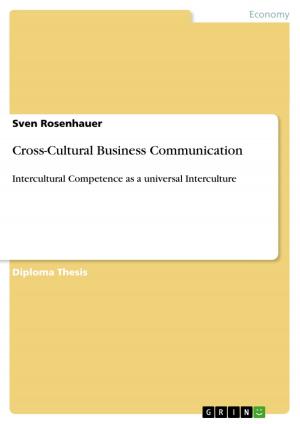Learning Strategies in First and Second Language Acquisition
Nonfiction, Entertainment, Drama, Anthologies| Author: | Matthias Gebhardt | ISBN: | 9783638589512 |
| Publisher: | GRIN Verlag | Publication: | January 8, 2007 |
| Imprint: | GRIN Verlag | Language: | English |
| Author: | Matthias Gebhardt |
| ISBN: | 9783638589512 |
| Publisher: | GRIN Verlag |
| Publication: | January 8, 2007 |
| Imprint: | GRIN Verlag |
| Language: | English |
Seminar paper from the year 2006 in the subject English Language and Literature Studies - Linguistics, grade: 2,0, Technical University of Braunschweig (Englisches Seminar - Abteilung Englische Sprache und ihre Didaktik), course: Child Discourse, 8 entries in the bibliography, language: English, abstract: Language itself as a means of communication as well as a carrier for thoughts, ideas and art is one of the factors that determine us as human beings. It distinguishes humans from animals and gives us the opportunity to pass along knowledge and memories. At the same time language is one of the most complex things our human brain has to master. It consists of a general concept of language, specific words and rules to use them. Moreover, language - in most cases - has to make sense in a specific context, otherwise it cannot be understood. Furthermore, the articulation of sounds and their reception is another highly complex process. As speaking and listening is so complicated it has to be learned from the early childhood on by every single person. At a certain age children begin to feel the need to communicate their wishes and insights they already gathered from this totally new world - at least from their point of view. This is what we call first language acquisition. Another area of language learning is the one of second language acquisition. This term describes the learning of a new language that is different from the mother tongue, i.e. the language that was learned in first language acquisition. It is also used when a person learns his third or fourth language to distinguish between the language learned as a native tongue and the one(s) learned as (a) foreign language(s). In both areas people somehow learn to communicate in a new way. Babies switch from pointing or crying to speaking and children or adults switch from using one language to using another. Here the question arises how they do it. Do they just learn some vocabulary by heart? Do they imitate other people's utterances and hope that they convey the meaning they hoped for? Today we know, that learning a language means using various learning strategies. These strategies are the topic of this paper. They are going to be presented to the reader first within the scope of second language acquisition. Later on I want to give some thoughts to whether the learning strategies described before may apply to first language acquisition as well. Finally some data on children's utterances shall be used to consolidate the previous considerations on learning strategies in first language acquisition.
Seminar paper from the year 2006 in the subject English Language and Literature Studies - Linguistics, grade: 2,0, Technical University of Braunschweig (Englisches Seminar - Abteilung Englische Sprache und ihre Didaktik), course: Child Discourse, 8 entries in the bibliography, language: English, abstract: Language itself as a means of communication as well as a carrier for thoughts, ideas and art is one of the factors that determine us as human beings. It distinguishes humans from animals and gives us the opportunity to pass along knowledge and memories. At the same time language is one of the most complex things our human brain has to master. It consists of a general concept of language, specific words and rules to use them. Moreover, language - in most cases - has to make sense in a specific context, otherwise it cannot be understood. Furthermore, the articulation of sounds and their reception is another highly complex process. As speaking and listening is so complicated it has to be learned from the early childhood on by every single person. At a certain age children begin to feel the need to communicate their wishes and insights they already gathered from this totally new world - at least from their point of view. This is what we call first language acquisition. Another area of language learning is the one of second language acquisition. This term describes the learning of a new language that is different from the mother tongue, i.e. the language that was learned in first language acquisition. It is also used when a person learns his third or fourth language to distinguish between the language learned as a native tongue and the one(s) learned as (a) foreign language(s). In both areas people somehow learn to communicate in a new way. Babies switch from pointing or crying to speaking and children or adults switch from using one language to using another. Here the question arises how they do it. Do they just learn some vocabulary by heart? Do they imitate other people's utterances and hope that they convey the meaning they hoped for? Today we know, that learning a language means using various learning strategies. These strategies are the topic of this paper. They are going to be presented to the reader first within the scope of second language acquisition. Later on I want to give some thoughts to whether the learning strategies described before may apply to first language acquisition as well. Finally some data on children's utterances shall be used to consolidate the previous considerations on learning strategies in first language acquisition.















